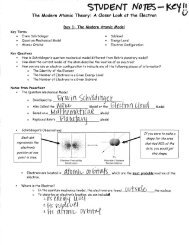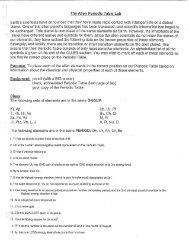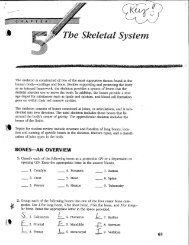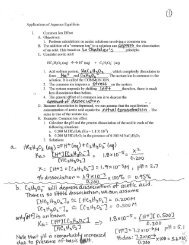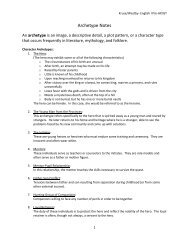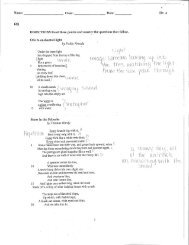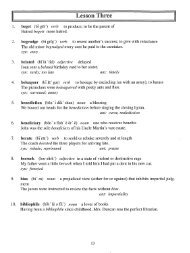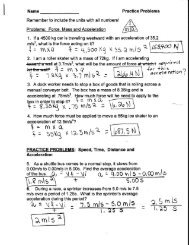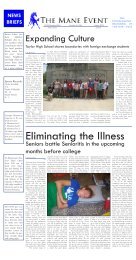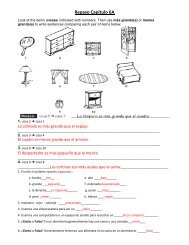Crucible Packet
Crucible Packet
Crucible Packet
You also want an ePaper? Increase the reach of your titles
YUMPU automatically turns print PDFs into web optimized ePapers that Google loves.
The <strong>Crucible</strong><br />
Review <strong>Packet</strong><br />
Name:<br />
Period:<br />
1
Arthur Miller (1915-2005)<br />
by Robert Anderson<br />
Arthur Miller, considered by many to be the pre-eminent American playwright of the second half of the twentieth<br />
century, was born in New York City. His father manufactured women’s coats, and his mother was a schoolteacher.<br />
In high school, Arthur was more involved with sports than with literature. “Until the age of seventeen,’ Miller said,<br />
“I can safely say that I never read a book weightier than Tom Swift and The Rover Boys, and only verged on<br />
literature with some Dickens.”<br />
On graduation from high school, Miller applied to the University of Michigan, but his grades were not good enough<br />
for a scholarship, and the Depression left his father unable to finance his tuition. To earn money for college, Miller<br />
worked for two years in an automobile parts plant, where, incidentally, he read Tolstoy’s War and Peace. The<br />
experience in the parts plant later supplied him with the material for his 1955 play A Memory of Two Mondays.<br />
Miller eventually enrolled in the University of Michigan. To help finance his education, he took on various jobs.<br />
First, he was a mouse tender in the university science laboratory. Later, he moved on (and up) to become the night<br />
editor of the Michigan Daily. More important, he started to write plays.<br />
After graduation, Miller returned to New York and, like many of us “playwrights-in-waiting,” earned a living by<br />
writing radio scripts for such programs as Cavalcade of America, the Columbia Workshop, and The Theatre Guild of<br />
the Air.<br />
Miller’s first Broadway success, All My Sons, was produced in 1947 and won The New York Drama Critic’s award<br />
for Best Play. That play struck a note that was to become familiar in Miller’s work: the need for moral<br />
responsibility in families and society.<br />
In 1949, with the production of his masterpiece, Death of a Salesman (written in a small studio he built with his own<br />
hands on his property in northwestern Connecticut), all promises were fulfilled. Miller instantly joined the pantheon<br />
of the great American playwrights.<br />
It was totally in character that Miller’s next play, produced in 1953, should be The <strong>Crucible</strong>—about a witch hunt<br />
that took place in 1692 in Salem, Massachusetts. In that witch hunt, Miller found parallels to the “Red hunt” being<br />
conducted in the 1950s Washington, D.C., by Senator Joseph McCarthy. Writers, actors, politicians—and all kinds<br />
of other people—were summoned to appear before McCarthy to answer the questions: “Are you now or were you<br />
ever a Communist?” Those summoned were required to inform on neighbors and friends or be sent to jail.<br />
Three years after the production of The <strong>Crucible</strong> in New York, Miller was summoned before a congressional<br />
committee. He spoke freely about himself and his occasional attendance, years before, as a guest at Communist<br />
meetings; but he refused to name names of other people in attendance. Miller was found in contempt of Congress,<br />
but his conviction was later overturned by the Supreme Court.<br />
The <strong>Crucible</strong> was not successful in its first production. Some critics questioned the comparison between the old<br />
witch-hunts and the contemporary hunt for Communists in government. In a later production, supervised by Miller<br />
himself, the play ran for over six hundred performances. It is now Miller’s most produced play.<br />
3
BACKGROUND for The <strong>Crucible</strong><br />
The setting for The <strong>Crucible</strong> is the Puritan community of Salem (now Danvers), Massachusetts,<br />
in 1692. The first Puritans were called by that name because they had attempted to “purify” or<br />
reform the Church of England by stripping way much of the ritual, ceremony, pomp, and terms.<br />
As they pared way what they considered the excesses of religion, the Puritans developed a lean,<br />
spare, somber form of religious worship.<br />
Their Doctrine of the Elect taught that people were fated from birth to be among the elect and<br />
saved, or among the damned and doomed. There was nothing a person could do to become a<br />
member of the elect; it was totally predestined by God. In terms of The <strong>Crucible</strong>, if certain<br />
people can be predestined by God to be saved, then it followed that he Devil could select certain<br />
individuals to be bewitched. In Calvinistic tradition, the Puritans placed emphasis on the fate of<br />
“sinners in the hands of an angry God.”<br />
The religious convictions of the Puritans filtered through all facets of their life, as the earliest<br />
settlers attempted to establish a form of government called a theocracy. In a theocracy God is<br />
the head of state, and religious authorities rule the state as God’s representatives. Ironically,<br />
many of those who came to America in search of religious freedom ended up on the side of<br />
religious authoritarianism and intolerance.<br />
The witch trials that took place in Salem, Massachusetts, in the early 1690s resulted in the<br />
execution of some twenty individuals (nineteen people were hanged, along with two dogs, and<br />
one person was pressed to death). This attempt to eradicate the evil of a community or country<br />
by identifying and eliminating certain individuals for collusion with the Devil (or for<br />
involvement in satanic and sinful plots) has fascinated the American imagination ever since.<br />
Indeed, the term “witch hunt” is commonly heard today applied not to the area of religion but to<br />
politics—any search for a scapegoat who can be blamed for all the ills of society and whose<br />
removal will eliminate the problems.<br />
In the early 1950s, Senator Joseph McCarthy (1909-1957) as chairman of a Senate investigating<br />
committee conducted such a hunt for, as he put it, pinkos, radicals, and communists, in and out<br />
of government. In the process, many innocent and talented people suffered damaged reputations<br />
and ostracism. Arthur Miller set The <strong>Crucible</strong> back in the Puritan period at the time of the witch<br />
trials, but his audiences know that his play was really about the McCarthy Senate hearings of the<br />
1950s.<br />
McCarthyism, the term derived from the senator’s name, developed during the cold war, a period<br />
after World War II in which there was a contest for power between the communist nations<br />
headed by the Soviet Union and the nations of the West headed by the United States. Today,<br />
McCarthyism is sometimes used to refer to the policy or practice of publicly accusing, in a<br />
reckless manner, suspected individuals or groups of political disloyalty and subversion.<br />
4
Puritan History<br />
In 1608 a group of Puritan separatists, attempting to escape religious persecution, fled England<br />
for the Netherlands. They remained there until 1620, but, fearing that they were losing their<br />
cultural identity, they decided to settle in Delaware in the New World. A mixed group of Puritan<br />
emigrants (the "Pilgrims") and adventurers from England sailed to America on the Mayflower<br />
and landed, accidentally, on Cape Cod in November 1620. Within five months half of the<br />
original 101 colonists were dead. During the course of the early seventeenth century, however,<br />
increasing numbers of immigrants, many but by no means all of them Puritans, managed to<br />
establish a group of autonomous North American colonies, including Plymouth (1620),<br />
Massachusetts (1628), New Hampshire (1629), Connecticut (1633), Maine (1635), Rhode Island<br />
(1636), and New Haven (1638). Like their counterparts in Britain they were extreme Calvinistic<br />
Protestants who viewed the Reformation as a victory of true Christianity over Roman<br />
Catholicism. They believed that the Universe was God- centered, and that man, inherently sinful<br />
and corrupt, rescued from damnation (if indeed he was) only by arbitrary divine grace, was dutybound<br />
to do God's will, which he could understand best by studying the Bible and the universe<br />
which God had created and which he controlled.<br />
Their isolation in the New World, their introversion, the harshness and dangers of their new<br />
existence, their sense that they were a new Chosen People of God destined to found a New<br />
Jerusalem -- a New City of God in the midst of the wilderness -- insured that American<br />
Puritanism would remain more severe (and, frequently, more intellectually subtle and rigorous)<br />
than that which they had left behind. The American Puritan tended to interpret the Bible, which<br />
had supreme literary value because it was the perfect word of God, even more literally than did<br />
his British counterparts. Though many of the original American Puritans -- many of whom were<br />
both preachers and authors -- had attended English Universities, they tended to form religious<br />
oligarchies and sought to establish a purified church -- which meant the frequently harsh<br />
imposition of religious uniformity upon an unwilling populace.<br />
It was to escape Puritan religious persecution that Roger Williams, a minister from Salem,<br />
established his colony in Rhode Island in 1636. The overt remnants of Puritanism did not die out<br />
in New England until well into the nineteenth century, and it echoes in American society today.<br />
In coming to the New World in the first place, Puritans altered the course of history, for better or<br />
for worse. There were approximately 4,000,000 English- speaking people in the entire world in<br />
1603: less than four centuries later there are over seventy-five times that number.<br />
5
Concepts of Puritanism in The <strong>Crucible</strong><br />
Some basic tenets of Puritanism are important to the full understanding of The <strong>Crucible</strong>. The<br />
first is the Doctrine of the Elect. The Puritans believed that when a person was born or at any<br />
given time later, he might be chosen by God to become one of the Elect, that is, one of the<br />
people who would receive divine salvation. There is nothing that man himself could do to<br />
achieve this state; instead, it was entirely predestined by God. Even though the Puritans never<br />
emphasized it, it was assumed that those who were not among the Elect would not receive divine<br />
salvation. The choice of who would be among the elect was completely arbitrary and no amount<br />
of good works, righteous living, or moral behavior could help a person achieve this status of<br />
being Elect. This concept is also called predestination. An individual could never tell whether<br />
he was among the Elect; therefore, he lived a righteous life so as to be prepared for being elected<br />
when the day came. It was furthermore assumed that if a person was among the Elect, he could<br />
do no wrong. The paradox in this type of belief is that if he were actually among the Elect, he<br />
could do wrong and would still be saved because once a person is elected, then he is saved<br />
forever.<br />
In terms of The <strong>Crucible</strong>, if God can then elect certain people to be saved, it was highly possible<br />
that the Devil could select certain people to be bewitched. For the Puritans, the Devil was not<br />
some abstract figure, but was a vivid and active enemy of mankind. Many stories tell of the<br />
“Black Man” who was lurking just outside the village gates or hiding in the forest waiting to trap<br />
a man and bring him into the ways of the Devil. The Puritans accepted that story that the Devil<br />
was one of God’s angels who had fallen from grace. After being thrown from heaven for<br />
betraying God, the Devil set up a continual campaign to destroy the designs of God. This<br />
concept is used in The <strong>Crucible</strong> when Reverend Hale mentions that the Devil’s ways are<br />
manifold and if the Devil were able to deceive God, then it would be easy for him to deceive<br />
man.<br />
Another concept of Puritanism that is important is the view of theocracy. The Puritans believed<br />
in a government that was totally controlled by the church. If a person was not a member of the<br />
church, he could not vote in elections, much less hold offices. During the earliest history of the<br />
church, the ministers were also the main officers and administrators of the civil government.<br />
This, if a person like John Proctor did not attend church, he could be punished and<br />
excommunicated from the church, thereby losing all of his property and rights. Furthermore, a<br />
man who did not know the catechism of the church also became suspect. The church was very<br />
powerful and the minister of the church wielded much authority.<br />
While the Puritan views about sin were strict, they also thought that every man was constantly<br />
being tempted by the Devil toward some sin. Part of the church belief was that once a man<br />
sinned he must first openly confess his sin, then repent and finally perform some act of penance.<br />
Without open confession, a person had no chance of ever being saved.<br />
In general, the Puritans were a sober and fearful group who felt that anything pleasant was<br />
inspired by the Devil. Women were forbidden to dress prettily; children were not expected to<br />
play games; theaters were forbidden as being the breeding place of the Devil; and dancing of any<br />
kind was a cardinal sin.<br />
6
Puritan Concepts of the Devil and Witches found in The <strong>Crucible</strong><br />
During the seventeenth century and well into the eighteenth century, belief in the reality of<br />
witches was widespread both in America and in Europe. Thousands of people were executed<br />
during the period; and few people questioned the actual existence of witches. The only problem<br />
to the seventeenth-century mind was how to identify a witch.<br />
The concept of the Devil grew out of basic tenets of Puritan religion. The Puritans accepted<br />
completely the doctrine of original sin and many sermons emphasized that man was born<br />
depraved and sinful. He was depicted as existing on the verge of eternal damnation and was seen<br />
as a potential colleague of the Devil. Given the view that man is on the verge of damnation and<br />
is born evil and depraved, it was then easy for the Puritan to see a devil hiding behind every tree<br />
ready to trap and ensnare man. For the Puritan, the Devil did not work alone. He employed<br />
many legions of helpers which were generally referred to as witches.<br />
The Puritan felt that the Devil had concentrated all of his attention upon destroying the New<br />
World. This view is a result of the Puritan belief that their religion was the new and only<br />
religion approved by God and that soon there would be a New Canaan in New England.<br />
Consequently, the Devil could most effectively destroy God’s purpose by attacking his new<br />
“chosen people” in the New Canaan. They also believed that the Devil held his strongest<br />
foothold in the New World because of the vast regions of forests and the vast numbers of<br />
barbarous savages existing in America.<br />
Knowing that the Devil’s time in which he could fulfill his destructive aims was limited, the<br />
Puritans could then readily accept the fact that he would employ legions of helpers—witches—to<br />
attack the New Canaan. They thought they had found his center of attack when they discovered<br />
so many witches in Salem, Massachusetts, a center of Puritanism. The Puritans were ready to<br />
accuse anyone of being a witch and accept anyone else’s accusation because they know that the<br />
Devil had to employ many witches to accomplish his goal before God’s kingdom was ultimately<br />
established.<br />
What a witch actually is and how to discover one was never solved by the Puritans. The Devil<br />
used witches to help him gain his goal and a person became a witch by entering into some type<br />
of covenant with the Devil. Once a person entered into this contract with the Devil, then that<br />
person would attack other innocent people. The identification becomes more complex when we<br />
realize that a witch could be invisible and could enter a person’s body without that person<br />
knowing it.<br />
Additional difficulties arise in discovering a witch when we realize that the Puritans also<br />
believed that the Devil or one of his agents could assume the shape of an innocent person and<br />
then torment another person. The tormented person then would automatically accuse the<br />
innocent person of being a witch and this innocent person would be punished for being in league<br />
with the Devil. By this subtle means, the Devil would gain his end of tormenting an innocent<br />
person and of bringing confusion into God’s world.<br />
7
Character study: For each of the following characters, write who she/he is, what<br />
relationship to other characters, any important character or personality traits and any other<br />
important information.<br />
Reverend Samuel Parris<br />
Betty Parris<br />
Abigail Williams<br />
Tituba<br />
Mrs. Ann Putnam<br />
Who is he/she? Relationship to<br />
whom?<br />
8<br />
Problem? Acts of<br />
courage/cowardice?
Thomas Putnam<br />
John Proctor<br />
Elizabeth Proctor<br />
Rebecca Nurse<br />
Reverend John Hale<br />
Think of what you mean when you use the words “honor,” “truth,” “justice,” or “courage.”<br />
Choose one character that exemplifies your idea of one of these ideals and explain how<br />
he/she lives up to your standards (or do the reverse: fails to live up to your standards).<br />
9
Act I<br />
Summary: Act one takes place in the upstairs bedroom of Reverend Samuel Parris in Salem,<br />
Massachusetts, 1692. A group of girls dance in the woods and are caught by Reverend Parris.<br />
Two of the girls fall sick, and the doctor does not know what is wrong. Rumors that the girls are<br />
bewitched begin to spread around the town, and Reverend John Hale is called from Beverly to<br />
Salem. As the town begins to gather in the home of Reverend Parris, the backgrounds and<br />
conflicts between the adults in the town are brought to light. As the tension increases, the girls<br />
begin to panic and the first accusations occur as the act comes to an end.<br />
Look up the word <strong>Crucible</strong> in the dictionary. What is the definition? Is there more than one?<br />
Which one best applies to the title? Write the definition below.<br />
______________________________________________________________________________<br />
______________________________________________________________________________<br />
______________________________________________________________________________<br />
______________________________________________________________________________<br />
______________________________________________________________________________<br />
Important Quotes:<br />
Abigail: Let either of you breathe a word, or the edge of a word, about the other things, and I<br />
will come to you in the black of some terrible night and I will bring a pointy reckoning that will<br />
shudder you. And you know I can do it; I saw Indians smash my dear parents’ heads on the<br />
pillow next to mine, and I have seen some reddish work done at night, and I can make you wish<br />
you had never seen the sun go down! (pg. 837)<br />
- What does this quote tell us about Abigail’s character?<br />
10
Abigail: I look for John Proctor that took me from my sleep and put knowledge in my heart! I<br />
never knew what pretense Salem was, I never know the lying lessons I was taught by all these<br />
Christian women and their covenanted men! And now you bid me tear the light out of my eyes?<br />
I will not, I cannot! (pg. 839)<br />
- How does this relate to the idea of the public life versus the private life?<br />
- What does Abigail mean by “tear the light out of my eyes?”<br />
Mrs. Putnam: But I must! You think it God’s work you should never lose a child, nor a<br />
grandchild either, and I bury all but one? There are wheels within wheels in this village, and<br />
fires within fires! (pg. 841)<br />
- Who is Mrs. Putnam talking to?<br />
- What is her motivation for the attack?<br />
Hale: Have no fear now—we shall find him out if he has come among us, and I mean to crush<br />
him utterly if he has shown his face! (845)<br />
- How does Reverend Hale see himself?<br />
- What role does he think he will play in Salem?<br />
11
1. What was Samuel Parris’s attitude toward children?<br />
2. Why do you think Rev. Parris has many enemies?<br />
3. After Parris begins to believe his daughter to be afflicted by witchcraft, what is Thomas<br />
Putnam’s advice to him?<br />
4. What truths come out when the adults leave the girls alone?<br />
5. What’s going on between Abigail and John Proctor?<br />
6. Why does Betty start screaming?<br />
7. Why are some people, including John Proctor, inclined to stay away from Sabbath<br />
meeting?<br />
8. Why does Hale believe the Devil would strike Rev. Parris’s house?<br />
9. Though Rev. Hale is trying to get Tituba to name her accomplices, who is the first person<br />
to actually mention names?<br />
10. Why isn’t it difficult for Ann Putnam to believe that Goody Osburn is a witch?<br />
12
Dramatic Plot Structure: Draw a diagram of the dramatic plot structure and label the parts.<br />
What part of the plot structure is Act One?<br />
13
Act II<br />
Summary: The setting is the farmhouse of John and Elizabeth Proctor, eight days after act one.<br />
The witch hunt is already in full gear. A court has been convened, with Abigail and the other<br />
girls as star witnesses, presenting new symptoms (and new accusations) daily. Elizabeth Proctor<br />
wants John to expose Abigail as a fraud, but he hesitates because of his past relationship with<br />
Abigail. Hale arrives to question the Proctors about their religious observance, but before he can<br />
finish, Elizabeth is arrested and jailed for the attempted murder of Abigail. The principle<br />
“evidence” is a doll with a needle in it, which Mary Warren has planted in the Proctor home on<br />
the same evening that Abigail has been discovered screaming, with a needle stuck in her belly.<br />
On this same evening, Rebecca Nurse is arrested, and Hale begins to doubt his mission.<br />
1. What do you know about the relationship between John and Elizabeth Proctor from the<br />
stage action and opening dialogue of Act II? What is the cause of the tension in their<br />
relationship?<br />
2. Describe the power Abigail has in the court room.<br />
3. What motivates Mary to bring the poppet into the house?<br />
4. What is the significance of Mary Warren standing up to John Proctor?<br />
14
5. Though Mary Warren cannot say who accused Elizabeth Proctor, who do you believe<br />
accused her and why?<br />
6. What commandment does John forget? Why is that important?<br />
7. What changes do we see in Reverend Hale? How has his attitude changed from Act<br />
One? What do you think motivates this change?<br />
8. Abigail is not physically present in this Act, but how does she make her presence known?<br />
9. John Proctor seems to be the only voice of reason in the confusing end of Act II. What<br />
are some examples to support this idea?<br />
10. Comment on Proctor’s feelings at the end of Act Two. Does his view towards Elizabeth<br />
change? If so, what motivates that change? If not, why?<br />
11. Why is Mary Warren afraid of telling the truth about Abigail, for herself and for John?<br />
15
Act III<br />
The setting is the Salem meeting house. Giles, Francis Nurse, and John attempt to present a<br />
petition to exacting, arrogant Judge Danforth, which testifies to the pious character of Rebecca<br />
Nurse, Martha Corey, and Elizabeth Proctor. From the beginning, this plan begins to go astray<br />
as Parris and Judge Hathorne accuse the men of coming to overthrow the court and seek to call in<br />
the signers of their petition. Danforth, however, is interested in the claim that Proctor’s servant,<br />
Mary Warren, has recanted her testimony and now swears the girls were feigning the effects of<br />
witchcraft. When Abigail haughtily denies this charge and begins to shrink from Mary’s “spell,”<br />
Proctor confesses his affair with Abigail. Danforth sends for the ever-truthful Elizabeth to<br />
corroborate John’s claim, but insists that she be warned of nothing. Recognizing a trap of some<br />
kind and hoping to save her husband’s life and reputation, Elizabeth denies the affair, destroying<br />
the last shreds of Proctor’s case. As Abigail and the girls fall into another witchcraft trance,<br />
Mary Warren in overwhelmed and accused John himself of witchcraft.<br />
1. _________________________ is accused of reading fortunes at the beginning of Act 3.<br />
2. The name of the proud judge who is in charge of the court and who is not ready to have<br />
his authority challenged. _________________________________________<br />
3. How many people has Deputy Governor Danforth jailed? ____________<br />
4. John Proctor is accused of ________________ on Sundays.<br />
5. Giles Corey believes that __________________ is having his daughter accuse George<br />
Jacobs, so he can get more land.<br />
6. Giles tells the judge that he has been a plaintiff in court __________ (number) times.<br />
7. When questioned about seeing spirits, Marry Warren said she had ____________.<br />
8. __________________ starts doubting the trials.<br />
9. Mary Warren supposedly takes the shape of a __________________________<br />
(color/animal) that wants to attack the faces of the other girls.<br />
10. Judge Hathorne asks Mary Warren to _____________, but she says she does not have a<br />
feel for it and she is unable to do it.<br />
11. Elizabeth Proctor tells the court she is pregnant so her life is saved for<br />
________________ (amount of time).<br />
16
12. What does John finally confess to everyone present in the court?<br />
________________________________________________________________________<br />
____________________________________________________________<br />
13. John Proctor tells the court that Elizabeth will not tell a ____________.<br />
14. In order to scare Mary Warren, Abigail and the other girls<br />
__________________________________________________________________<br />
15. _______________________ & __________________________ are taken to jail at the<br />
end of Act Three.<br />
16. Why does Elizabeth lie about John’s affair with Abigail?<br />
________________________________________________________________________<br />
____________________________________________________________<br />
17. What was the strongest motive behind Abigail’s actions during the play?<br />
_______________________<br />
18. _________________________ accuses John Proctor of forcing her to lie.<br />
19. Over and over, Danforth says that the good have nothing to fear. What evidence can you<br />
give to show that the opposite is true?<br />
20. Summarize the guidelines that Danforth gives for judging a witch.<br />
21. Mary Warren’s testimony is destroyed in the end because she cannot do something.<br />
What? How does she explain the problem?<br />
17
Act IV<br />
22. Finally, Proctor admits that he and Abigail have been lovers. This truth could be the end<br />
of Abigail’s control. Why isn’t it?<br />
23. What is the importance of John Proctor’s last speech (in Act III)?<br />
The summer passes and autumn arrives. The witch trials have caused unrest in neighboring towns,<br />
and Danforth grows nervous. Abigail has run away, taking all of Parris’s money with her. Hale, who<br />
has lost faith in the court, begs the accused witches to confess falsely in order to save their lives, but<br />
they refuse. Danforth, however, has an idea: he asks Elizabeth to talk John into confessing, and she<br />
agrees. Conflicted, but desiring to live, John agrees to confess, and the officers of the court rejoice.<br />
But he refuses to incriminate anyone else, and when the court insists that the confession must be<br />
made public, Proctor grows angry, tears it up, and retracts his admission of guilt. Despite Hale’s<br />
desperate pleas, Proctor goes to the gallows with the others, and the witch trials reach their awful<br />
conclusion.<br />
1. According to Parris, what has happened to Abigail Williams and Mercy Lewis?<br />
________________________________________________________________________<br />
________________________________________________________________________<br />
________________________________________________________________________<br />
________________________________________________________________________<br />
2. ______________________ &_____________________ urge Deputy Governor Danforth<br />
to postpone the trials because they fear rebellion.<br />
3. Reverend Parris finds a _________________ in his front door.<br />
18
4. What does Reverend Hale ask Elizabeth to do?<br />
________________________________________________________________________<br />
____________________________________________________________<br />
5. How does Giles die?<br />
________________________________________________________________________<br />
____________________________________________________________<br />
6. Elizabeth blames herself for ___________________________________________<br />
7. What does keeping “a cold house” mean?<br />
________________________________________________________________________<br />
____________________________________________________________<br />
8. What does John plead for from Elizabeth?<br />
__________________________________________________________________<br />
9. Why won’t Danforth delay the executions?<br />
________________________________________________________________________<br />
____________________________________________________________<br />
10. List what John Proctor admits to in his confession to the court.<br />
________________________________________________________________________<br />
________________________________________________________________________<br />
______________________________________________________<br />
11. Does Elizabeth tell John to confess? Why does she refuse?<br />
________________________________________________________________________<br />
________________________________________________________________________<br />
______________________________________________________<br />
19
12. Why does Giles not confess to save his life?<br />
________________________________________________________________________<br />
____________________________________________________________<br />
13. What does Proctor decide?<br />
________________________________________________________________________<br />
____________________________________________________________<br />
14. Proctor will / will not sign his name on the confession. (circle one)<br />
15. What is Hale’s mission in Act IV?<br />
16. Parris tells Danforth, “You cannot hang this sort” (123). What does he mean?<br />
17. Why won’t Danforth pardon the prisoners?<br />
18. Do you think Elizabeth Proctor would confess if she were in her husband’s place?<br />
Explain.<br />
19. In the end, what is it that is of utmost importance to John Proctor?<br />
20



